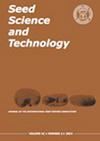Invited Review: Use of the tetrazolium test for estimating the physiological quality of seeds
IF 3
4区 农林科学
Q2 AGRONOMY
引用次数: 7
Abstract
The tetrazolium test has been developed and improved since the early years of the 20th century. Hundreds of seed specialists have dedicated their efforts for perfecting the methodology of the test for several species. Among these seeds experts, two of them deserve special recognition, Dr. Georg Lakon and Dr. Robert P. Moore, whose achievements had fundamental importance for the further development of the test. The test relies on the activity of certain dehydrogenase enzymes and indirectly measures the respiration capability of the living tissues of the seeds. The initial objective of the test was to quickly determine seed viability. Later on, it focussed on estimating seed vigour and more recently in diagnosing the possible causes that contribute to reduce the physiological quality of seed lots, such as mechanical damage, weathering damage and insect problems. Nowadays, the methodology of the tetrazolium test has been perfected for seeds of several species, including agricultural, vegetable, horticultural, flower, tree and shrub species. Seed quality control is improved with the use of the tetrazolium test in all phases of seed production such as harvesting, receiving, before and after seed processing and drying, during storage and before sowing. The test can be applied even before harvesting the crop. The methods for determining vigour will be briefly presented for seeds of the following species: cotton, common bean, maize, soybean, wheat, sunflower, peanut, Solanaceae, and tropical forage grass seeds. The utilisation of tetrazolium results, as with any vigour test, can assist the categorisation of vigour levels for different seed lots and for estimating the performance of these lots in the field under optimum and stressful conditions.特邀综述:四氮唑试验在种子生理品质评价中的应用
自20世纪初以来,四氮唑试验得到了发展和改进。数百名种子专家致力于完善几个物种的测试方法。在这些种子专家中,有两位值得特别表彰,他们是乔治·拉孔博士和罗伯特·摩尔博士,他们的成就对进一步发展这项试验具有根本的重要性。该试验依靠某些脱氢酶的活性,间接测量种子活组织的呼吸能力。该试验的最初目的是快速确定种子的生存能力。后来,它集中于估计种子活力,最近则集中于诊断导致种子生理质量下降的可能原因,如机械损伤、风化损伤和昆虫问题。目前,对农业、蔬菜、园艺、花卉、乔木和灌木等多种植物种子的四氮唑检测方法已趋于完善。在种子生产的所有阶段,如收获、接收、种子加工前后和干燥、储存期间和播种前,使用四氮唑试验可以改善种子质量控制。这种测试甚至可以在收获作物之前进行。本文将简要介绍以下几种种子的活力测定方法:棉花、蚕豆、玉米、大豆、小麦、向日葵、花生、茄科植物和热带牧草种子。利用tetrazolium的结果,与任何活力测试一样,可以帮助对不同种子批次的活力水平进行分类,并估计这些批次在最佳和压力条件下的田间表现。
本文章由计算机程序翻译,如有差异,请以英文原文为准。
求助全文
约1分钟内获得全文
求助全文
来源期刊

Seed Science and Technology
农林科学-农艺学
CiteScore
3.00
自引率
28.60%
发文量
36
审稿时长
>36 weeks
期刊介绍:
Seed Science and Technology (SST) is an international journal featuring original papers and articles on seed quality and physiology related to seed production, harvest, processing, sampling, storage, genetic conservation, habitat regeneration, distribution and testing. A journal that meets the needs of researchers, advisers and all those involved in the improvement and technical control of seed quality. Published every April, August and December.
 求助内容:
求助内容: 应助结果提醒方式:
应助结果提醒方式:


